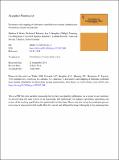Decimeter-scale mapping of carbonate-controlled trace element distribution in Neoarchean cuspate stromatolites
Abstract
Ancient stromatolites can provide key insights into the early evolution of life on Earth. Neoarchean fenestrate stromatolites from the ∼2520 Ma Upper Nauga Formation (Transvaal Supergroup, South Africa) preserve cuspate morphologies. They possess clearly delineated support and drape structures interpreted as dolomitized microbial mat material. Petrographic observations show that the biogenic structures are composed of planar-s to non-planar ferroan dolomite, encased in ferroan calcite, including herringbone calcite textures. The cuspate stromatolites were analyzed using Synchrotron Rapid Scanning X-Ray Fluorescence (SRS-XRF) and more conventional techniques to determine: (i) whether element distributions could be distinguished in ancient stromatolites at both cm to dm scales, (ii) whether element distributions show variation between biogenic and abiogenic textures, and (iii) the sample’s paragenesis. The distributions of Ca, Fe, Mn, Pb, Cu, As, Br, Al, Si, P, and S directly correspond to dolomitized stromatolitic structures and show trace element distributions are principally controlled by calcite and dolomite occurrence. Dolomite formation was mainly driven by seawater-derived fluids given the high concentrations of Fe and retention of marine shale-normalized rare earth element and yttrium (REYSN) patterns, however the spatial association of dolomite to stromatolite structures may reflect microbially-influenced mineral nucleation. Given the complexity of this sample’s paragenetic evolution, trace metal distributions cannot be conclusively tied to specific metabolic pathways, bioaccumulation or passive binding, however, the results show SRS-XRF can be used for quantifiable, spatial, in-situ investigation of ancient microbialites.
Citation
Warke , M R , Edwards , N P , Wogelius , R A , Manning , P L , Bergmann , U , Egerton , V M , Kimball , K C , Garwood , R J , Beukes , N J & Schröder , S 2019 , ' Decimeter-scale mapping of carbonate-controlled trace element distribution in Neoarchean cuspate stromatolites ' , Geochimica et Cosmochimica Acta , vol. 261 . https://doi.org/10.1016/j.gca.2019.07.004
Publication
Geochimica et Cosmochimica Acta
Status
Peer reviewed
ISSN
0016-7037Type
Journal article
Description
MRW was funded by a NERC PhD studentship at the University of Manchester. PLM thanks STFC for their support (ST/M001814/1). We are grateful to SSRL for continued support for imaging at beamline 6-2 at SLAC. We are also grateful to the Manchester X-Ray Imaging Facility, which was funded in part by the EPSRC (grants EP/F007906/1, EP/F001452/1 and EP/I02249X/1).Collections
Items in the St Andrews Research Repository are protected by copyright, with all rights reserved, unless otherwise indicated.

